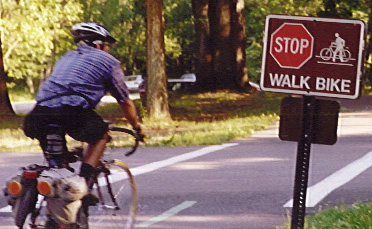 |
 |
|
1.
Avoid Riding On Sidewalks. Many people think that the sidewalk
is a safe place to ride. However, accident studies show that riding
on sidewalks has about twice the accident risk as proper cycling on the
road. Sidewalk cyclists are in danger at every road crossing and
even driveways because motorists do not look for fast traffic on the sidewalk.
Also, mixing pedestrians and cyclists is dangerous to both. A bicycle
“sidepath” next to a road is just about as dangerous as a sidewalk.
This is why cyclists are often required to walk bikes across intersections.
(Note the sign in the photo to the right.) You are much safer in
the street, following the rules of the road for drivers of vehicles.
|
 |
|
2.
Ride On The Right With Other Traffic. Some people were taught
to ride on the wrong side of the road so they can “see traffic coming”.
This is dangerous and it is illegal in all 50 states. Pedestrians walk facing traffic so they can sidestep off the
road, if necessary. But you cannot sidestep on a bike. The accident
rate for wrong-way cyclists is 3.6 times as high as for cycling the "right"
way. Other
drivers look for traffic coming from the usual direction. They usually are not looking for wrong way traffic.
|
|
3. Be
Visible!
Other drivers will not hit you IF they can see you. Bright clothes make
you easier to spot in the daytime but they are useless at night. Riding without lights in the dark is a
very dangerous mistake. About thirty percent of cycling crashes occur at
night although only about four percent of cycling is done then. The
reflectors that come with new bikes are grossly inadequate for nighttime
safety. Always use a headlight and taillight when you ride in the dark.
If you are caught by darkness without lights don't try to sneak home on the
sidewalk. Walk your bike home or call for a ride. The photo at
right shows the author's machine with two headlights. Notice how little
of the bike is visible other than the headlights.
|
 |
|
5.
Learn Proper Lane Position. Beginners usually “hug the curb”
and then wonder why cars pass so close. Experienced cyclists let
traffic pass when they can but they “take the lane” when needed for safety.
If cars are passing you too close, move a bit left to signal to
passing drivers that they must use another lane to pass. If you collect
a string of cars behind you, try to find a safe way to let them pass.
It takes practice to learn to ride effectively in traffic. The right
tire track of the right lane is often a good place to ride on a narrow
road. (See the photo at right.)
|
For more information about cycling and bicycle transportation, see the
author's advocacy section on the Crankmail Web Site:
http://www.crankmail.com/bike-res.html.
The author is a bicycle commuter from the Cleveland area and a Professional Engineer in Ohio.
last revised 3 Dec 2001
** The principle behind Effective Cycling: